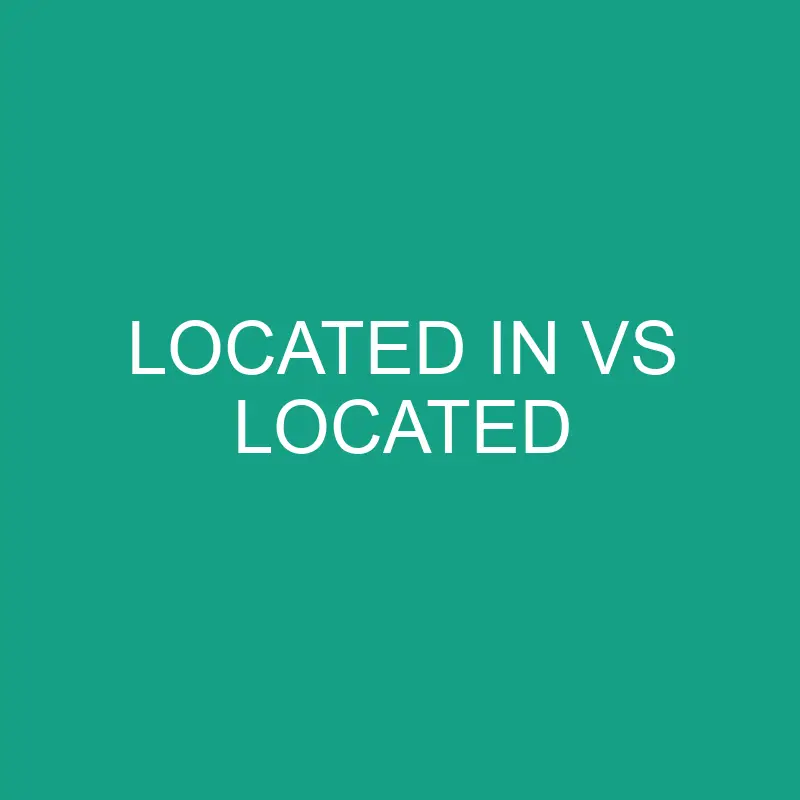Unraveling the Nuances: “Located In” vs. “Located At”
In the realm of language and prepositions, the choice between “located in” and “located at” might seem trivial at first glance. However, subtle nuances can significantly impact the precision and clarity of communication. Whether you are describing a place, a city, or a specific spot, understanding when to use “in” and when to use “at” can elevate your language proficiency. Let’s delve into the intricacies of “located in” and “located at” to unravel the distinctions between these seemingly interchangeable phrases.
Post Contents
- Understanding the Basics: Prepositions and Location
- Navigating Geographical Boundaries: “In” and “At” in Different Contexts
- Functional Differences: “In” and “At” in Various Scenarios
- Aesthetic Considerations: Nuances in Style and Tone
- Cultural and Idiomatic Variations: Regional Language Dynamics
- Conclusion: Choosing the Right Fit for Precision and Elegance
Understanding the Basics: Prepositions and Location
**1. “Located In”: Embracing the Space Within
“Located in” is a phrase that is often employed when referring to a broader area or a space within certain boundaries. It implies being situated within the confines or limits of a particular place.
Example:
- “The park is located in the heart of the city.”
In this context, “in” is used to convey that the park exists within the central part of the city.
**2. “Located At”: Precision in Specifics
On the other hand, “located at” tends to be more specific, pinpointing a particular spot or addressing a location with a higher degree of precision. It can be applied to specific addresses, landmarks, or points on a map.
Example:
- “The conference is located at 123 Main Street.”
Here, “at” is employed to highlight the specific address where the conference is taking place.
**1. Geographical Regions and Larger Spaces: “Located In”
When describing countries, cities, states, or large geographical regions, “located in” is often the appropriate choice. It emphasizes existence within the broader boundaries of a place.
Example:
- “Paris is located in France.”
In this instance, “in” is used to convey that Paris is situated within the larger geographical entity of France.
**2. Specific Addresses and Points: “Located At”
For pinpointing exact addresses, landmarks, or specific points, “located at” is more fitting. It provides a sense of precision, guiding the listener or reader to a particular spot.
Example:
- “The bookstore is located at the corner of Maple Street and Elm Avenue.”
Here, “at” is used to specify the precise location of the bookstore at the intersection of Maple Street and Elm Avenue.
Functional Differences: “In” and “At” in Various Scenarios
**1. General Areas and Spaces: “Located In”
When referring to general areas or spaces that don’t have a specific address but exist within broader parameters, “located in” is apt.
Example:
- “The museum is located in the cultural district.”
In this case, “in” is employed to express that the museum is situated within the cultural district, which is a general area.
**2. Events and Gatherings: “Located At”
For events, gatherings, or occasions, especially those with specific addresses or venues, “located at” offers clarity.
Example:
- “The concert is located at the amphitheater downtown.”
Here, “at” is chosen to emphasize the specific venue, the amphitheater downtown.
Aesthetic Considerations: Nuances in Style and Tone
**1. “Located In”: Elegance in Description
“Located in” can bring an added layer of elegance and expansiveness to descriptions. It often finds its place in narratives or descriptions that aim to evoke a sense of the overall ambiance or context.
Example:
- “The resort is located in a serene valley.”
The use of “in” here conveys a sense of the resort being situated within the larger, tranquil setting of a valley.
**2. “Located At”: Directness and Pragmatism
“Located at,” with its precision, is straightforward and pragmatic. It aligns well with contexts that require clear and concise information, leaving little room for ambiguity.
Example:
- “The meeting is located at the conference room on the third floor.”
Here, “at” is chosen for its directness in indicating the specific location of the meeting.
Cultural and Idiomatic Variations: Regional Language Dynamics
**1. Cultural and Linguistic Differences
Language is dynamic, and usage can vary across regions and cultures. In some cases, the choice between “in” and “at” might align with local linguistic norms and idiomatic expressions.
Example:
- “The market is located at the high street.”
Here, the local linguistic norm might favor the use of “at” when referring to the high street.
**2. Idiomatic Phrases and Prepositional Habits
Certain phrases and expressions might dictate the use of one preposition over the other in specific regions. Understanding these idiomatic variations can enhance language proficiency.
Example:
- “The office is located in the heart of downtown.”
In this instance, the idiomatic use of “in the heart of” is a regional preference.
Conclusion: Choosing the Right Fit for Precision and Elegance
In the grand tapestry of language, the choice between “located in” and “located at” serves as a subtle brushstroke that colors our expressions with precision or expansiveness. Both phrases are tools in the linguistic toolbox, and their selection depends on the context, the level of detail required, and sometimes, the aesthetic nuances one wishes to convey.
So, the next time you find yourself describing a place, a venue, or a city, consider whether you’re encapsulating the broader ambiance (“located in”) or if you’re pinpointing a specific spot or address (“located at”). The beauty of language lies in its ability to navigate such subtleties, and the art is in choosing the right preposition to craft a clear and evocative message.
